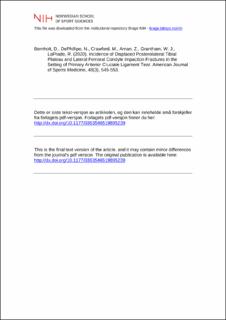| dc.contributor.author | Bernholt, David | |
| dc.contributor.author | DePhillipo, Nicholas | |
| dc.contributor.author | Crawford, Matthew | |
| dc.contributor.author | Aman, Zachary | |
| dc.contributor.author | Grantham, W. Jeffrey | |
| dc.contributor.author | LaPrade, Robert | |
| dc.date.accessioned | 2020-10-21T06:20:36Z | |
| dc.date.available | 2020-10-21T06:20:36Z | |
| dc.date.created | 2020-09-03T13:10:03Z | |
| dc.date.issued | 2020 | |
| dc.identifier.citation | American Journal of Sports Medicine. 2020, 48(3), 545-553. | en_US |
| dc.identifier.issn | 0363-5465 | |
| dc.identifier.uri | https://hdl.handle.net/11250/2684004 | |
| dc.description | I Brage finner du siste tekst-versjon av artikkelen, og den kan inneholde ubetydelige forskjeller fra forlagets pdf-versjon. Forlagets pdf-versjon finner du på journals.sagepub.com / In Brage you'll find the final text version of the article, and it may contain insignificant differences from the journal's pdf version. The definitive version is available at journals.sagepub.com | en_US |
| dc.description.abstract | Background: Bone bruising of the posterolateral tibial plateau and the lateral femoral condyle sulcus terminalis has a well-established association with anterior cruciate ligament (ACL) tears. Impaction fractures of the femur and tibia may occur in these locations; however, there is a paucity of literature describing these fractures.
Purpose: The primary objective was to quantify the incidence, size, and location of impaction fractures of the posterolateral tibial plateau and lateral femoral condyle in patients with primary ACL tears. The secondary objective was to investigate the association between impaction fractures and concomitant meniscal and ligamentous injuries.
Study Design: Case series; Level of evidence 4.
Methods: Patients with available magnetic resonance imaging (MRI) scans who were treated for primary ACL tear by a single surgeon were identified. MRI scans were reviewed with denotation of posterolateral tibial and femoral condylar contusions and displaced impaction fractures. Measurements of the lateral tibial plateau were taken in all patients with displaced lateral tibial plateau fractures and in a subset of control patients without tibial plateau fracture present to characterize the size and location of the bony lesion. Associations of impaction fractures with concomitant meniscal or ligamentous injuries were evaluated through use of chi-square testing.
Results: There were 825 knees identified with available MRI scans. Lateral tibial plateau bone bruising was present in 634 knees (76.8%), and lateral femoral condyle bone bruising was present in 407 knees (49.3%). Posterolateral tibial plateau impaction fractures were present in 407 knees (49.3%), and lateral femoral condylar impaction fractures were present in 214 knees (25.9%). Patients with posterolateral tibial plateau impaction fractures were older than patients without these fractures (42.6 vs 32.7 years; P < .001), whereas patients with lateral femoral condylar impaction fractures were younger (23.8 vs 32.7 years; P < .001). There were 71 knees (8.6%) with a posterolateral tibial plateau impaction fracture with greater than 10% loss of lateral tibial plateau depth, and this group had an increased incidence of lateral meniscus posterior root tears (22.1% vs 12.0%; P = .02).
Conclusion: Posterolateral tibial plateau impaction fractures occurred with a high incidence (49.3%) in patients with primary ACL tears and demonstrated an increased association with lateral meniscus posterior horn root tears as their size increased. Lateral femoral condylar impaction fractures occurred in 25.9% of patients with primary ACL tears and entailed an increased incidence of lateral meniscal tears and medial meniscal ramp lesions. | en_US |
| dc.language.iso | eng | en_US |
| dc.subject | tibial plateau | en_US |
| dc.subject | impaction fracture | |
| dc.subject | ACL tear | |
| dc.title | Incidence of Displaced Posterolateral Tibial Plateau and Lateral Femoral Condyle Impaction Fractures in the Setting of Primary Anterior Cruciate Ligament Tear | en_US |
| dc.type | Peer reviewed | en_US |
| dc.type | Journal article | en_US |
| dc.description.version | acceptedVersion | en_US |
| dc.source.pagenumber | 545-553 | en_US |
| dc.source.volume | 48 | en_US |
| dc.source.journal | American Journal of Sports Medicine | en_US |
| dc.source.issue | 3 | en_US |
| dc.identifier.doi | 10.1177/0363546519895239 | |
| dc.identifier.cristin | 1827069 | |
| dc.description.localcode | Institutt for idrettsmedisinske fag / Department of Sports Medicine | en_US |
| cristin.ispublished | true | |
| cristin.fulltext | postprint | |
| cristin.qualitycode | 2 | |
